I am not sure how I got into daylilies at the bottom of the world. One day I realised I had seven colours and I decided I would see what other daylilies looked like. There was no one to warn me that this was a mistake. That was some 20……kilograms ago. The addiction is now quite advanced.
Daylilies were excellent plants for a beginner. They were so easy to grow and were not susceptible to disease. I do not know how rust got into my garden. I had read about it being in the northern hemisphere and had heard that it was spreading. I knew it eventually would come to Australia. I had watched other diseases tragically go global, but I did hope that being on a small island off the mainland might cause it to pass me by. It arrived about six years ago. The ugly orange pustules were just suddenly there.
Looking back, I wish I had known about the technique of potting and isolating the new plants I was buying to see whether they had rust before planting. Regrets. But thanks to the people on ATP I have the fungus much under control now.
The next thing I learned about daylilies was that I was supposed to grow only semi-evergreens and evergreens in my subtropical climate, but I have a habit of ordering an attractive daylily and being absent-minded about the foliage. I don’t think this is too smart, but so far all of my mis-ordered dormants have thrived. I have a sneaking suspicion that the different foliage types are rules of the thumb rather than real differences, but I will see whether I can manage to handle Primal Scream in the coming seasons. This one is by choice, however. If you look, at the popularity polls in North America, it is the star, and I intend to purposefully tame this dormant.
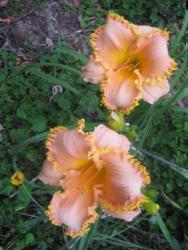
FORESTLAKE RAGAMUFFIN, one of my several, excellently performing dormants.
I found that daylilies did not like being stood upon. I am usually the main culprit, but stone-curlews and ibises are the runners-up. I use large stakes next to the seedlings to keep me at bay, but birds take smaller shortcuts. For them, I have to surround seedlings with pointed bamboo satay sticks, pointy-ends-out -- like the spines of a Short-Beaked Echidna. This works quite well. But my poor LUNAR MAX: I have stood on it two years in a row. Now I wonder whether it will ever bloom.
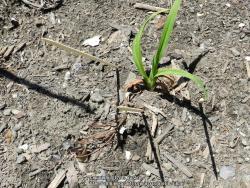
Pointed satay sticks prickling outward to discourage birds. This LUNAR MAX fan is three years old. I keep standing on it.
Spines do not work for bandicoots or cockatoos. Brown Bandicoots are nocturnal and shy, but this cat-sized marsupial loves to dig for larvae, and sometimes the seedlings get thrown about. Ibises, of course, just pull them out. They don’t like plants being in the way of a worm.

Australian White Ibises are serious pluckers and tossers.
The true terrors of daylilies have very large sharp beaks and claws: Sulphur-Crested Cockatoos. They are very large parrots and they just love bright flowers, which they shred. With daylilies, they then slice through the scapes and rend the fans. They like lily bulbs too and dig them up for slice and dice.
You have to be very careful not to annoy these birds. Don't let their beauty and cuteness fool you. A group of irate cockatoos is an elemental force if you forget their bird seed. They strut around, leaving dismembered plants in their wake.
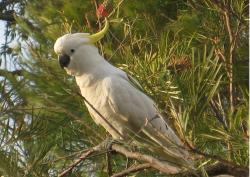
Sulphur-Crested Cockatoos are large and imposing parrots with anti-daylily beaks.
My garden, however, is for wildlife as much as it is for daylilies. Even so, some days I think I deserve a medal. Take the way I have to put up with the koels eating all my cherry tomatoes, for instance. The very good thing about these cuckoos is that they migrate north in the colder months. Love/hate. Sadly, I miss their voices when they go: Summer is very much the season of the males calling “cooo-eee,” a very Australian sound.

Male Australian Koel having a rest after devouring a very large number of my tomatoes.
But back to daylilies: What great plants they are for sub-tropical Australian conditions. In all months except June and July (the first two months of our winter), I have some clumps flowering. My stand-out is MARY ETHEL ANDERSON: It does 6-7 months by itself. DOUBLE ROSEDALE is up there too. PLANET MAX is a forest of continuing blooms. My late reblooms of OLYMPIC SHOWCASE and CLEDA JONES are always throwing up doubles or polys, which are wonderful surprises and are immensely satisfying for a gardener.
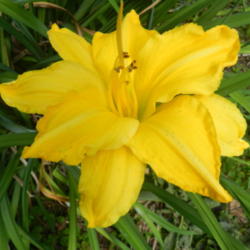
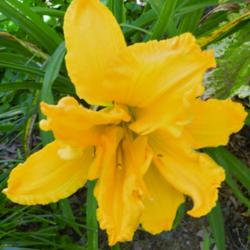
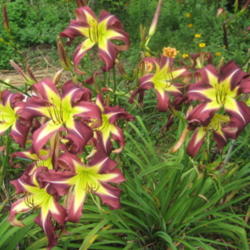


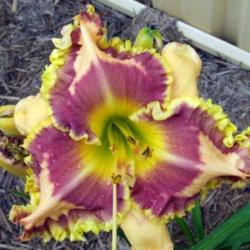

| Thread Title | Last Reply | Replies |
|---|---|---|
| The grass is always greener? by flaflwrgrl | Aug 18, 2014 6:59 AM | 22 |